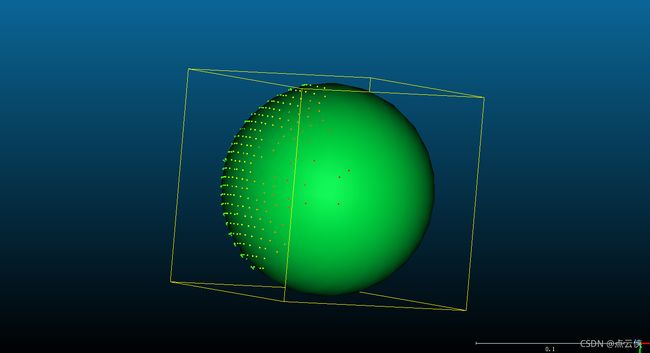- 【练习】【二分】力扣热题100 34. 在排序数组中查找元素的第一个和最后一个位置
柠石榴
输入输出力扣hot100leetcode算法c++二分
题目给你一个按照非递减顺序排列的整数数组nums,和一个目标值target。请你找出给定目标值在数组中的开始位置和结束位置。如果数组中不存在目标值target,返回[-1,-1]。你必须设计并实现时间复杂度为O(logn)的算法解决此问题。示例1:输入:nums=[5,7,7,8,8,10],target=8输出:[3,4]示例2:输入:nums=[5,7,7,8,8,10],target=6输出
- 动态规划之背包问题
于冬恋
动态规划算法
动态规划是一个重要的算法范式,它将一个问题分解为一系列更小的子问题,并通过存储子问题的解来避免重复计算,从而大幅提升时间效率。目录01背包问题完全背包问题多重背包问题二维费用背包问题(1)01背包问题给定n个物体,和一个容量为c的背包,物品i的重量为wi,其价值为应该如何选择装入背包的物品使其获得的总价值最大。可以用贪心算法,但是不一定能达到最优解,所以用动态规划解决创建一个数组dp[i][j]i
- 在瑞芯微RK3588平台上使用RKNN部署YOLOv8Pose模型的C++实战指南
机 _ 长
YOLO系列模型有效涨点改进深度学习落地实战YOLOc++开发语言
在人工智能和计算机视觉领域,人体姿态估计是一项极具挑战性的任务,它对于理解人类行为、增强人机交互等方面具有重要意义。YOLOv8Pose作为YOLO系列中的新成员,以其高效和准确性在人体姿态估计任务中脱颖而出。本文将详细介绍如何在瑞芯微RK3588平台上,使用RKNN(RockchipNeuralNetworkToolkit)框架部署YOLOv8Pose模型,并进行C++代码的编译和运行。注本文全
- 十大排序算法
myprogramc
排序算法算法数据结构
排序算法插入排序冒泡排序选择排序希尔排序计数排序快速排序1经典Lomuto分区法2经典Lomuto分区法3随机快排堆排序归并排序桶排序基数排序插入排序从i=1开始,判断nums[i-1]和nums[i]的大小,一直到nums[i]插入到自己的位置。模拟抓扑克牌的过程:将元素插入到已排序的部分,使其有序voidinsertionSort(vector&nums){for(inti=1;i=0&&nu
- 【CUDA】Pytorch_Extensions
joker D888
深度学习pytorchpythoncudac++深度学习
【CUDA】Pytorch_Extensions为什么要开发CUDA扩展?当我们在PyTorch中实现自定义算子时,通常有两种选择:使用纯Python实现(简单但效率低)使用C++/CUDA扩展(高效但需要编译)对于计算密集型的操作(如神经网络中的自定义激活函数),使用CUDA扩展可以获得接近硬件极限的性能。本文将以实现一个多项式激活函数x²+x+1为例,展示完整的开发流程。完整CUDA扩展代码解
- 侯捷 C++ 课程学习笔记:C++ 面向对象开发的艺术
孤寂大仙v
c++c++学习笔记
在侯捷老师的C++系列课程中,《C++面向对象开发》这门课程让我对面向对象编程有了更深入的理解。面向对象编程(OOP)是现代软件开发中最重要的编程范式之一,而C++作为支持OOP的语言,提供了强大的工具和特性。侯捷老师通过系统的讲解和实战案例,帮助我掌握了如何在C++中高效地使用面向对象技术。以下是我对这门课程的学习笔记和心得体会。一、课程核心内容:C++面向对象开发的关键特性{tot+=db;});returntot;}templateTaverage_list(c
- C++ C_style string overview and basic Input funcitons
狗头鹰
C++notesc++开发语言
writeinadvance最近在做题,遇到一个简单的将console的输入输出到文件中的简单题目,没有写出来。悔恨当初没有踏实地总结string相关的I/O以及与文件的操作。这篇文章旨在记录基础的字符I/O,简单常用的文件I/O操作函数。当然,你会说C++已经有一个stringclass,我们只需要#include就能够使用它带来的便捷性及强大的功能,无需烦恼细节。但知道底层的具体情况在语言的学
- 十大经典排序算法的C++实现与解析
金外飞176
算法算法数据结构c++
经典排序算法的C++实现与解析在计算机科学中,排序算法是数据处理和算法设计的基础。无论是处理大规模数据还是优化小规模数据的性能,排序算法都扮演着重要角色。本文将介绍10种经典排序算法,并提供它们的C++实现代码。这些算法包括冒泡排序、选择排序、插入排序、希尔排序、归并排序、快速排序、堆排序、计数排序、基数排序和桶排序。1.冒泡排序(BubbleSort)原理冒泡排序是最简单的排序算法之一。它通过重
- C++(23):lambda可以省略()
风静如云
C/C++c++
C++越来越多的使用了lambda,C++23也进一步的放宽了对lambda的限制,这一次,如果lambda没有参数列表,那么可以直接省略掉():#includeusingnamespacestd;voidfunc(){autof=[]{cout<<"inf"<<endl;};f();}intmain(){func();return0;}允许程序输出:inf
- BP 神经网络在考古数据分析中的应用
fanxbl957
人工智能理论与实践神经网络数据分析人工智能
BP神经网络在考古数据分析中的应用摘要:本文深入探讨了BP神经网络在考古数据分析领域的应用。首先阐述了考古数据分析的重要性以及传统分析方法的局限性。随后详细介绍了BP神经网络的结构、原理与训练算法。通过丰富的代码示例展示了如何运用BP神经网络进行考古文物的分类鉴定、年代预测以及遗址空间分布分析等任务,涵盖数据预处理、网络构建、模型训练与评估等关键环节。分析了该应用的优势与局限性,并对其在考古数据分
- DeepSeek原理介绍以及对网络安全行业的影响
AI拉呱
Deepseek人工智能
大家好,我是AI拉呱,一个专注于人工智领域与网络安全方面的博主,现任资深算法研究员一职,兼职硕士研究生导师;热爱机器学习和深度学习算法应用,深耕大语言模型微调、量化、私域部署。曾获多次获得AI竞赛大奖,拥有多项发明专利和学术论文。对于AI算法有自己独特见解和经验。曾辅导十几位非计算机学生转行到算法岗位就业。关注评审分享一起学习更多知识。1.DeepSeek公司介绍1.1DeepSeek是什么:wh
- 23种设计模式-享元(Flyweight)设计模式
萨达大
软考中级-软件设计师设计模式享元模式软考软件设计师C++行为型设计模式JAVA
文章目录一.什么是享元设计模式?二.享元模式的特点三.享元模式的结构四.享元模式的优缺点五.享元模式的C++实现六.享元模式的JAVA实现七.代码解析八.总结类图:享元设计模式类图一.什么是享元设计模式? 享元(Flyweight)设计模式是一种结构型设计模式,通过共享对象来减少内存占用和对象创建开销。它通过将对象的可共享部分与不可共享部分分离,减少重复对象的数量,从而节省内存。 享元模式的核心思
- JS宏实例:数据透视工具的制作(三)
jackispy
JS宏实例javascript前端java
数据透视工具的制作(二)中详细展示了窗体设计思路及想要实现的功能,在本节中,将完成该工具中的核心计算代码,如分组求和、计数、累乘等的实现方式。在这里,我们可以构思两个类:TablePivot:主要用于管理数据矩阵,包括自动识别列数据类型,以及实现数据分组功能。GroupBy:对分组后的数据进行各种统计操作,例如求和、计数、求平均值等。一、TablePivot类1、示例代码classTablePiv
- 基于python深度学习遥感影像地物分类与目标识别、分割实践技术应用
xiao5kou4chang6kai4
深度学习遥感勘测python深度学习分类
专题一:深度学习发展与机器学习深度学习的历史发展过程机器学习,深度学习等任务的基本处理流程梯度下降算法讲解不同初始化,学习率对梯度下降算法的实例分析从机器学习到深度学习算法专题二深度卷积网络、卷积神经网络、卷积运算的基本原理池化操作,全连接层,以及分类器的作用BP反向传播算法的理解一个简单CNN模型代码理解特征图,卷积核可视化分析专题三TensorFlow与keras介绍与入门TensorFlow
- flutter pigeon gomobile 插件中使用go工具类
yujunlong3919
fluttergolangswiftkotlin
文章目录为什么flutter要用go写工具类1.下载pigeon插件模版2.编写go代码3.生成greeting.aar,Greeting.xcframework4.ios5.android6.dart中使用为什么flutter要用go写工具类在Flutter应用中,有些场景涉及到大量的计算,比如复杂的加密算法、数据压缩/解压缩或者图形处理中的数学计算等1.下载pigeon插件模版base_plu
- muzero 算法原理
战神哥
Muzero算法是一种通用的强化学习算法,它可以在没有预先设定策略的情况下进行学习。它通过模拟整个游戏进程来自我学习,并通过回报函数来评估每一步的决策。Muzero算法的核心部分是一个叫做模型的神经网络,它会对游戏的状态进行预测,预测未来的游戏状态。另一部分是策略网络,它会根据当前状态预测每一步的最优决策。Muzero算法通过不断地训练模型和策略网络,来提高它们的准确性,从而使得机器学到了如何玩游
- LLM与知识图谱融合:智能运维知识库构建
AI天才研究院
DeepSeekR1&大数据AI人工智能大模型AI大模型企业级应用开发实战AI实战计算科学神经计算深度学习神经网络大数据人工智能大型语言模型AIAGILLMJavaPython架构设计AgentRPA
1.背景介绍随着信息技术的飞速发展,IT运维管理面临着越来越大的挑战。海量的设备、复杂的网络环境、日益增长的数据量,使得传统的运维方式难以满足需求。为了提高运维效率和质量,智能运维应运而生。智能运维的核心是将人工智能技术应用于运维领域,通过机器学习、深度学习等算法,实现自动化、智能化的运维管理。其中,大语言模型(LLM)和知识图谱是两个重要的技术方向。LLM能够理解和生成自然语言,可以用于构建智能
- LQB---基础练习---十六进制转八进制
「已注销」
#LQBLQB
试题基础练习十六进制转八进制资源限制内存限制:512.0MBC/C++时间限制:1.0sJava时间限制:3.0sPython时间限制:5.0s问题描述给定n个十六进制正整数,输出它们对应的八进制数。输入格式输入的第一行为一个正整数n(1<=n<=10)。接下来n行,每行一个由09、大写字母AF组成的字符串,表示要转换的十六进制正整数,每个十六进制数长度不超过100000。输出格式输出n行,每行为
- C++ 多线程
lly202406
开发语言
C++多线程引言在计算机科学中,多线程是一种常用的技术,它允许一个程序同时执行多个任务。C++作为一门强大的编程语言,提供了多种多线程编程的机制。本文将详细介绍C++多线程编程的相关知识,包括多线程的概念、线程的创建与同步、互斥锁的使用等。一、多线程的概念1.1什么是多线程?多线程指的是在同一程序中,可以同时运行多个线程,每个线程都是程序的一个执行流。这些线程可以并行执行,从而提高程序的执行效率。
- LQB(4)-python-DFS搜索
AAA顶置摸鱼
蓝桥杯python组深度优先算法python蓝桥杯
前言DFS即深度优先搜索(Depth-FirstSearch),是一种用于遍历或搜索树或图的算法,有三种核心的应用场景(基础遍历、回溯、剪枝)。一、DFS-基础遍历1.核心原理深度优先搜索(DFS)是一种遍历或搜索树/图的算法,优先沿着一条路径尽可能深入,直到无法继续再回溯。实现方式:递归:隐式利用系统调用栈。栈模拟:显式使用栈数据结构。2.代码实现(1)递归实现(树结构)classTreeNod
- C++ 设计模式-外观模式
ox0080
#北漂+滴滴出行C++设计模式VIP激励c++外观模式开发语言
外观模式的定义外观模式是一种结构型设计模式,它通过提供一个简化的接口来隐藏系统的复杂性。外观模式的核心思想是:封装复杂子系统:将多个复杂的子系统或组件封装在一个统一的接口后面。提供简单接口:为客户端提供一个更简单、更易用的接口,而不需要客户端直接与复杂的子系统交互。外观模式就像一个“前台接待员”,客户端只需要与这个接待员打交道,而不需要了解后台复杂的运作机制。外观模式的核心思想简化接口外观模式通过
- sklearn.ConfusionMatrixDisplay可视化混淆矩阵
Cachel wood
python机器学习和数据挖掘sklearn矩阵人工智能python机器学习vue.jsjava
文章目录ConfusionMatrixDisplay详细解释更多定制化ConfusionMatrixDisplayConfusionMatrixDisplay是scikit-learn库中用于可视化混淆矩阵的一个实用工具。混淆矩阵是一种常用的评估分类模型性能的工具,它可以直观地展示模型在各个类别上的预测结果与真实标签之间的关系。下面详细介绍如何使用ConfusionMatrixDisplay进行混
- handpose_X 之 onnx runtime C++(手部关键点检测)
Xian-HHappy
手部关键点检测ONNXONNXRuntimeC++推理模型转换
handpose_X之onnxruntime相关项目地址:1、手部关键点检测项目地址:https://gitcode.net/EricLee/handpose_x该项目中通过脚本model2onnx.py,将.pth模型转为.onnx模型。示例视频:开源项目-手势识别手势检测手部21关键点检测2、手部关键点检测onnx模型,onnxruntimeC++模型推理。项目地址:https://gitco
- QT C++ new QTableWidgetItem 不需要删除指针
测控系统集成
c++语言测控QT数据库qt
在Qt中,使用QTableWidgetItem时,通常不需要手动删除指针,除非你是在使用原始指针而非智能指针(如std::unique_ptr或std::shared_ptr)。这是因为QTableWidgetItem本身是Qt框架的一部分,它负责管理自己的内存。1.使用QTableWidgetItem当你向QTableWidget添加项时,可以直接创建并添加QTableWidgetItem对象,
- Hadoop(一)
朱辉辉33
hadooplinux
今天在诺基亚第一天开始培训大数据,因为之前没接触过Linux,所以这次一起学了,任务量还是蛮大的。
首先下载安装了Xshell软件,然后公司给了账号密码连接上了河南郑州那边的服务器,接下来开始按照给的资料学习,全英文的,头也不讲解,说锻炼我们的学习能力,然后就开始跌跌撞撞的自学。这里写部分已经运行成功的代码吧.
在hdfs下,运行hadoop fs -mkdir /u
- maven An error occurred while filtering resources
blackproof
maven报错
转:http://stackoverflow.com/questions/18145774/eclipse-an-error-occurred-while-filtering-resources
maven报错:
maven An error occurred while filtering resources
Maven -> Update Proje
- jdk常用故障排查命令
daysinsun
jvm
linux下常见定位命令:
1、jps 输出Java进程
-q 只输出进程ID的名称,省略主类的名称;
-m 输出进程启动时传递给main函数的参数;
&nb
- java 位移运算与乘法运算
周凡杨
java位移运算乘法
对于 JAVA 编程中,适当的采用位移运算,会减少代码的运行时间,提高项目的运行效率。这个可以从一道面试题说起:
问题:
用最有效率的方法算出2 乘以8 等於几?”
答案:2 << 3
由此就引发了我的思考,为什么位移运算会比乘法运算更快呢?其实简单的想想,计算机的内存是用由 0 和 1 组成的二
- java中的枚举(enmu)
g21121
java
从jdk1.5开始,java增加了enum(枚举)这个类型,但是大家在平时运用中还是比较少用到枚举的,而且很多人和我一样对枚举一知半解,下面就跟大家一起学习下enmu枚举。先看一个最简单的枚举类型,一个返回类型的枚举:
public enum ResultType {
/**
* 成功
*/
SUCCESS,
/**
* 失败
*/
FAIL,
- MQ初级学习
510888780
activemq
1.下载ActiveMQ
去官方网站下载:http://activemq.apache.org/
2.运行ActiveMQ
解压缩apache-activemq-5.9.0-bin.zip到C盘,然后双击apache-activemq-5.9.0-\bin\activemq-admin.bat运行ActiveMQ程序。
启动ActiveMQ以后,登陆:http://localhos
- Spring_Transactional_Propagation
布衣凌宇
springtransactional
//事务传播属性
@Transactional(propagation=Propagation.REQUIRED)//如果有事务,那么加入事务,没有的话新创建一个
@Transactional(propagation=Propagation.NOT_SUPPORTED)//这个方法不开启事务
@Transactional(propagation=Propagation.REQUIREDS_N
- 我的spring学习笔记12-idref与ref的区别
aijuans
spring
idref用来将容器内其他bean的id传给<constructor-arg>/<property>元素,同时提供错误验证功能。例如:
<bean id ="theTargetBean" class="..." />
<bean id ="theClientBean" class=&quo
- Jqplot之折线图
antlove
jsjqueryWebtimeseriesjqplot
timeseriesChart.html
<script type="text/javascript" src="jslib/jquery.min.js"></script>
<script type="text/javascript" src="jslib/excanvas.min.js&
- JDBC中事务处理应用
百合不是茶
javaJDBC编程事务控制语句
解释事务的概念; 事务控制是sql语句中的核心之一;事务控制的作用就是保证数据的正常执行与异常之后可以恢复
事务常用命令:
Commit提交
- [转]ConcurrentHashMap Collections.synchronizedMap和Hashtable讨论
bijian1013
java多线程线程安全HashMap
在Java类库中出现的第一个关联的集合类是Hashtable,它是JDK1.0的一部分。 Hashtable提供了一种易于使用的、线程安全的、关联的map功能,这当然也是方便的。然而,线程安全性是凭代价换来的――Hashtable的所有方法都是同步的。此时,无竞争的同步会导致可观的性能代价。Hashtable的后继者HashMap是作为JDK1.2中的集合框架的一部分出现的,它通过提供一个不同步的
- ng-if与ng-show、ng-hide指令的区别和注意事项
bijian1013
JavaScriptAngularJS
angularJS中的ng-show、ng-hide、ng-if指令都可以用来控制dom元素的显示或隐藏。ng-show和ng-hide根据所给表达式的值来显示或隐藏HTML元素。当赋值给ng-show指令的值为false时元素会被隐藏,值为true时元素会显示。ng-hide功能类似,使用方式相反。元素的显示或
- 【持久化框架MyBatis3七】MyBatis3定义typeHandler
bit1129
TypeHandler
什么是typeHandler?
typeHandler用于将某个类型的数据映射到表的某一列上,以完成MyBatis列跟某个属性的映射
内置typeHandler
MyBatis内置了很多typeHandler,这写typeHandler通过org.apache.ibatis.type.TypeHandlerRegistry进行注册,比如对于日期型数据的typeHandler,
- 上传下载文件rz,sz命令
bitcarter
linux命令rz
刚开始使用rz上传和sz下载命令:
因为我们是通过secureCRT终端工具进行使用的所以会有上传下载这样的需求:
我遇到的问题:
sz下载A文件10M左右,没有问题
但是将这个文件A再传到另一天服务器上时就出现传不上去,甚至出现乱码,死掉现象,具体问题
解决方法:
上传命令改为;rz -ybe
下载命令改为:sz -be filename
如果还是有问题:
那就是文
- 通过ngx-lua来统计nginx上的虚拟主机性能数据
ronin47
ngx-lua 统计 解禁ip
介绍
以前我们为nginx做统计,都是通过对日志的分析来完成.比较麻烦,现在基于ngx_lua插件,开发了实时统计站点状态的脚本,解放生产力.项目主页: https://github.com/skyeydemon/ngx-lua-stats 功能
支持分不同虚拟主机统计, 同一个虚拟主机下可以分不同的location统计.
可以统计与query-times request-time
- java-68-把数组排成最小的数。一个正整数数组,将它们连接起来排成一个数,输出能排出的所有数字中最小的。例如输入数组{32, 321},则输出32132
bylijinnan
java
import java.util.Arrays;
import java.util.Comparator;
public class MinNumFromIntArray {
/**
* Q68输入一个正整数数组,将它们连接起来排成一个数,输出能排出的所有数字中最小的一个。
* 例如输入数组{32, 321},则输出这两个能排成的最小数字32132。请给出解决问题
- Oracle基本操作
ccii
Oracle SQL总结Oracle SQL语法Oracle基本操作Oracle SQL
一、表操作
1. 常用数据类型
NUMBER(p,s):可变长度的数字。p表示整数加小数的最大位数,s为最大小数位数。支持最大精度为38位
NVARCHAR2(size):变长字符串,最大长度为4000字节(以字符数为单位)
VARCHAR2(size):变长字符串,最大长度为4000字节(以字节数为单位)
CHAR(size):定长字符串,最大长度为2000字节,最小为1字节,默认
- [强人工智能]实现强人工智能的路线图
comsci
人工智能
1:创建一个用于记录拓扑网络连接的矩阵数据表
2:自动构造或者人工复制一个包含10万个连接(1000*1000)的流程图
3:将这个流程图导入到矩阵数据表中
4:在矩阵的每个有意义的节点中嵌入一段简单的
- 给Tomcat,Apache配置gzip压缩(HTTP压缩)功能
cwqcwqmax9
apache
背景:
HTTP 压缩可以大大提高浏览网站的速度,它的原理是,在客户端请求网页后,从服务器端将网页文件压缩,再下载到客户端,由客户端的浏览器负责解压缩并浏览。相对于普通的浏览过程HTML ,CSS,Javascript , Text ,它可以节省40%左右的流量。更为重要的是,它可以对动态生成的,包括CGI、PHP , JSP , ASP , Servlet,SHTML等输出的网页也能进行压缩,
- SpringMVC and Struts2
dashuaifu
struts2springMVC
SpringMVC VS Struts2
1:
spring3开发效率高于struts
2:
spring3 mvc可以认为已经100%零配置
3:
struts2是类级别的拦截, 一个类对应一个request上下文,
springmvc是方法级别的拦截,一个方法对应一个request上下文,而方法同时又跟一个url对应
所以说从架构本身上 spring3 mvc就容易实现r
- windows常用命令行命令
dcj3sjt126com
windowscmdcommand
在windows系统中,点击开始-运行,可以直接输入命令行,快速打开一些原本需要多次点击图标才能打开的界面,如常用的输入cmd打开dos命令行,输入taskmgr打开任务管理器。此处列出了网上搜集到的一些常用命令。winver 检查windows版本 wmimgmt.msc 打开windows管理体系结构(wmi) wupdmgr windows更新程序 wscrip
- 再看知名应用背后的第三方开源项目
dcj3sjt126com
ios
知名应用程序的设计和技术一直都是开发者需要学习的,同样这些应用所使用的开源框架也是不可忽视的一部分。此前《
iOS第三方开源库的吐槽和备忘》中作者ibireme列举了国内多款知名应用所使用的开源框架,并对其中一些框架进行了分析,同样国外开发者
@iOSCowboy也在博客中给我们列出了国外多款知名应用使用的开源框架。另外txx's blog中详细介绍了
Facebook Paper使用的第三
- Objective-c单例模式的正确写法
jsntghf
单例iosiPhone
一般情况下,可能我们写的单例模式是这样的:
#import <Foundation/Foundation.h>
@interface Downloader : NSObject
+ (instancetype)sharedDownloader;
@end
#import "Downloader.h"
@implementation
- jquery easyui datagrid 加载成功,选中某一行
hae
jqueryeasyuidatagrid数据加载
1.首先你需要设置datagrid的onLoadSuccess
$(
'#dg'
).datagrid({onLoadSuccess :
function
(data){
$(
'#dg'
).datagrid(
'selectRow'
,3);
}});
2.onL
- jQuery用户数字打分评价效果
ini
JavaScripthtmljqueryWebcss
效果体验:http://hovertree.com/texiao/jquery/5.htmHTML文件代码:
<!DOCTYPE html>
<html xmlns="http://www.w3.org/1999/xhtml">
<head>
<title>jQuery用户数字打分评分代码 - HoverTree</
- mybatis的paramType
kerryg
DAOsql
MyBatis传多个参数:
1、采用#{0},#{1}获得参数:
Dao层函数方法:
public User selectUser(String name,String area);
对应的Mapper.xml
<select id="selectUser" result
- centos 7安装mysql5.5
MrLee23
centos
首先centos7 已经不支持mysql,因为收费了你懂得,所以内部集成了mariadb,而安装mysql的话会和mariadb的文件冲突,所以需要先卸载掉mariadb,以下为卸载mariadb,安装mysql的步骤。
#列出所有被安装的rpm package rpm -qa | grep mariadb
#卸载
rpm -e mariadb-libs-5.
- 利用thrift来实现消息群发
qifeifei
thrift
Thrift项目一般用来做内部项目接偶用的,还有能跨不同语言的功能,非常方便,一般前端系统和后台server线上都是3个节点,然后前端通过获取client来访问后台server,那么如果是多太server,就是有一个负载均衡的方法,然后最后访问其中一个节点。那么换个思路,能不能发送给所有节点的server呢,如果能就
- 实现一个sizeof获取Java对象大小
teasp
javaHotSpot内存对象大小sizeof
由于Java的设计者不想让程序员管理和了解内存的使用,我们想要知道一个对象在内存中的大小变得比较困难了。本文提供了可以获取对象的大小的方法,但是由于各个虚拟机在内存使用上可能存在不同,因此该方法不能在各虚拟机上都适用,而是仅在hotspot 32位虚拟机上,或者其它内存管理方式与hotspot 32位虚拟机相同的虚拟机上 适用。
- SVN错误及处理
xiangqian0505
SVN提交文件时服务器强行关闭
在SVN服务控制台打开资源库“SVN无法读取current” ---摘自网络 写道 SVN无法读取current修复方法 Can't read file : End of file found
文件:repository/db/txn_current、repository/db/current
其中current记录当前最新版本号,txn_current记录版本库中版本
![]()



